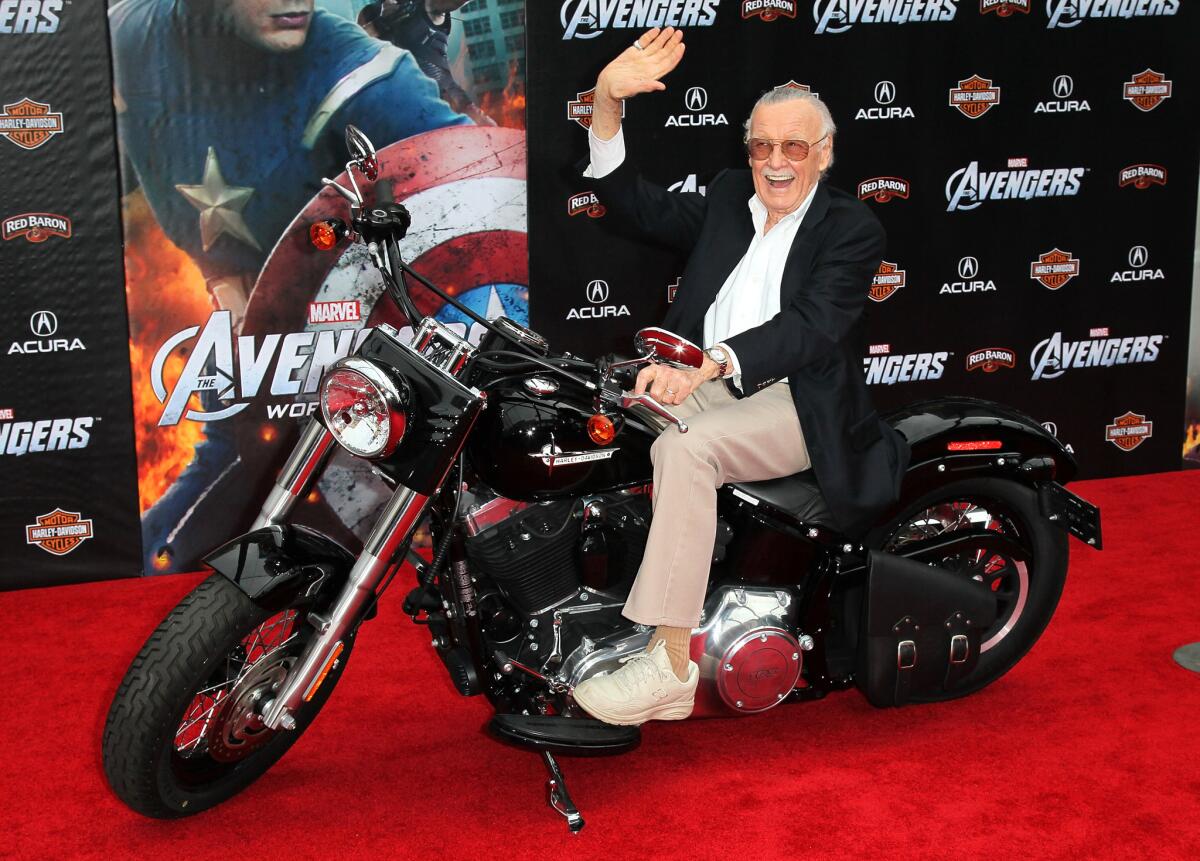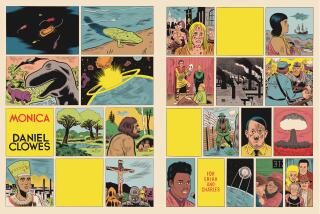Review: Comic book icon Stan Lee’s ‘Amazing Fantastic Incredible’ memoir doesn’t live up to the superlatives

Stan Lee attends the premiere of Marvel Studios’ “Marvel’s The Avengers” at the El Capitan Theatre on April 11, 2012.
- Share via
There’s one kind of memoir in which men and women of letters reflect on the details of an important period in their lives or look back thoughtfully at their careers. There’s another kind that piggybacks on the celebrity of bold-faced names, repeating familiar tales of cultural success from the perspective of the author (in many cases, as told to another writer). In “Amazing Fantastic Incredible: A Marvelous Memoir,” Stan Lee, the 92-year-old co-creator of most of Marvel Comics’ best-known superheroes, has managed to combine these two approaches: He may be the first famous writer to publish a ghostwritten memoir.
Or, rather, a semi-ghostwritten, graphic memoir. “Amazing Fantastic Incredible” was apparently adapted by veteran comics writer Peter David from Lee’s 2002 prose memoir “Excelsior!: The Amazing Life of Stan Lee” (itself co-credited to George Mair) and updated by Lee. It was drawn by Colleen Doran (“A Distant Soil”) on what she has indicated was an exceptionally tight deadline; as she’s noted on her blog, “yes, Stan really did do writing on this and I have the script to prove it.”
Doran’s artwork is studded with sly visual allusions (artist Jack Kirby’s cigar smoke is full of “Kirby crackle,” the oversized dots he drew to suggest cosmic energy; Lee’s first meeting with his future wife is presented as a homage to Peter Parker’s first encounter with Mary Jane Watson), as well as a lot of images of Lee striking grand, hammy poses, as he’s renowned for doing. “Stan’s approach was basically this: Think silent movies,” artist John Romita recalled in 2002.
Lee’s first comics-writing byline appeared in an issue of Captain America in 1941, and he still knocks out a short script a couple of times a year for nostalgia’s sake. But his fame is based on his work between 1961, when he and Kirby launched Fantastic Four, and 1971, when he stepped away from Fantastic Four, Amazing Spider-Man and Thor, the last three monthly series he was writing. His writing before and after those years is forgettable at best.
And yet, many of the comics Lee wrote and edited during his decade of glory are extraordinary, thrilling and charming, exploding with off-the-cuff inventiveness. It’s easy enough to give most of the credit to the artists with whom he collaborated, especially Kirby and Steve Ditko — particularly since one of Lee’s great innovations was to cut superhero comics’ artists a wider berth than they’d ever had before. (He’d describe a plot to them, let them figure out how to present it visually, and then fill in dialogue and captions once the story was drawn.) But Kirby and Ditko, as well as many of the other artists with whom Lee worked in the 1960s, never did better work than they did with him: Lee knew how to get the best from his collaborators and how to make their wildest inventions clear and compelling.
That decade sits at the heart of “Amazing Fantastic Incredible,” although Lee hopscotches around. In one eight-page span, he rambles from a dramatization of Marvel’s 1965 fan-club record to the shutdown of the fan club in 1969 to Jim Steranko’s launch of FOOM magazine in 1973 to a 1980 White House photo-op to the departure of Ditko in 1966.
Earlier, we get to see a bit of his Depression-era childhood and his experiences writing training films for troops during World War II. Much of the book’s second half, meanwhile, is devoted to the last 40 years, which Lee has spent as the glib but avuncular representative of Marvel, the Borscht Belt comedian who turns up for a bit part in every Marvel movie, the huckster who lets you know up front that he’s handing you a line.
“Amazing Fantastic Incredible” features a handful of well-worn anecdotes — the story of how Lee named the Punisher, for instance, is quoted verbatim from Jordan Raphael and Tom Spurgeon’s 2003 biography “Stan Lee and the Rise and Fall of the American Comic Book.” But it’s short on revelations and glosses over the conflicts of Lee’s career. He doesn’t have much to say about the end of his collaborations with Ditko (“Whatever the reason, there was no longer any warmth to our relationship”) and Kirby (“It’s hard to correct a misunderstanding if you don’t know what it is that’s misunderstood”).
A discussion of Marvel’s turbulent business history in the 1990s is interrupted by a few pages of writing tips and the story of how Lee met Fabio; the remarkable dot-com-era crash-and-burn of Stan Lee Media is brushed aside in a single panel (“It ended badly and the less said the better”).
There’s a fascinating story to be told about how Lee and his 1960s collaborators invented a mythology so durable that it has grown in fame for half a century, but “Amazing Fantastic Incredible” is not that book.
::
Amazing Fantastic Incredible
A Marvelous Memoir
Stan Lee and Peter David and Colleen Doran
Touchstone: 192 pp., $30
Wolk is the author of “Reading Comics: How Graphic Novels Work and What They Mean.”
More to Read
Sign up for our Book Club newsletter
Get the latest news, events and more from the Los Angeles Times Book Club, and help us get L.A. reading and talking.
You may occasionally receive promotional content from the Los Angeles Times.








